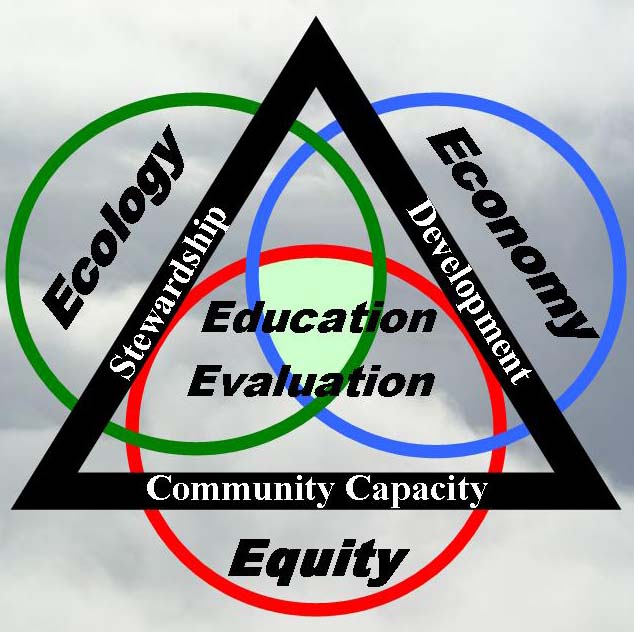|
The quality
of human life in the future is about the choices we make.
For our choices and actions to be sustainable, they must
be ever elastic, adaptable, and creative. You can plan and
plan, but then also leave yourself open to mystery and discovery;
for biophysical research and ecosystem science have demonstrated
the interdependent functions in nature, as well as between
nature and humans, and how recognition of these interconnections
is important to preventing harm from our actions (Jacobs,
2000; Norton, 2005).
But the difficulty that arises from the complex issue of sustainable
development is considering the following: we may have equal
or better economic opportunities than our ancestors, but do
we have more social and environmental benefits or opportunities?
Sustainable development involves the carrying out of activities
that offer economic benefits in the present without negatively
affecting social and environmental choices that are available
to people in the future, or in other places.
Most discussions about the meaning
of sustainable development are usually reduced to the Brundtland
Commission
statement
that we should be concerned about the "needs of the future" in
our thinking about sustainability. Sustainable futures, however,
are not clear in advance. Instead of attempting to understand
the potential needs of the future, which is really impossible
to do, present societal members, through a program of participatory
social experimentation and learning, should instead be concerned
about making sure that the opportunities they have to achieve
their own values, the things important to them, are not in
any way constrained for other places or the future by actions
they might take. And this process must encourage the connection
of scientific information with cherished human values.
To hold options open requires
the complicated and difficult process of a community attempting
to conscientiously
specify
what obligations toward people in other places and the future
it accepts, which require protection of the stuff so designated
as long as present society’s costs are bearable, and
to compare those ideals its members would like to project into
the future with the very real and present needs of people in
the present generation (Norton, 2005). If individuals fulfill
their needs in such a way as to destroy important options,
for example individuals in earlier generations over-consume
and do not create new opportunities, changing the environment
that subsequent generations encounter, than this leaves more
constraints and reduces opportunities, making survival more
difficult.
In other words, people should
be concerned about making sure the opportunities they have
to achieve their own core
values,
the things important to them (range of environmental, social,
and economic opportunities), are not in any way constrained
for other places or people in the future by actions taken today.
When we state a set of ideals (values) for what we want our
community to be like, we identify those options and opportunities
that give meaning to life in a place (Norton, 2005) for the
present and for as much as we know about the future. “Important
options” represent a variable to be specified as particular
communities articulate their values and decide what is important
to save for posterity. “An action or a policy is not
sustainable if it will reduce the ratio of opportunities to
constraints on people in the future” (Norton, 2005).
All people today should have
sufficient resources (human, financial, environmental)
to meet their needs, provided
in
a way that does not interfere with the ecological integrity
of natural systems (options always depend upon having healthy
environments and productive natural resources), so that similar
options will be open to future generations. Our task ahead
is to shape a sustainable future, using resources less intensively,
where “resources” includes those things that support
our economic and social productivity while also absorbing our
waste products, by combining social, economic and environmental
strategies that produce opportunities and minimize constraints
for future generations (Norton, 2005) and people in other places
through the practice of sustainable development.
The bottom line: communities
themselves are responsible for choosing what is important
to monitor and what is important
to protect, not inhibited by some kind of sustainability definition
established somewhere else. Acting sustainably, assuring sufficiency
and opportunity, guarantees a resource will not fall below
a threshold required to perpetuate it through time as a foundation
to insure all people have sufficient resources to achieve a
decent life and that everyone has opportunities to seek improvements
in ways that do not compromise future generations (Gibson,
2006). In many instances it comes down to differentiating “needs” from “wants.” Decision-making
should encourage equitable distribution of resources to create
a sense of fairness, identifying and satisfying real needs
before wants and leaving options open for future generations.
Living sustainably is maintaining the important mix of options
and opportunities while creating no new and burdensome constraints;
living unsustainably is losing them, narrowing the range of
options that people in other places or subsequent generations
can choose among in their attempt to adapt, survive, and prosper
(Flint, 2006). Sustainability is most fundamentally equality
over time and place, making sure we consume less than Earth’s
natural resources can provide. Economic development that is
sustainable must be both environmentally sound and shared fairly
among all societal members. Not to meet this objective is to
open the doors of conflict.
References:
Flint, R.W. 2006. Water resource sustainable management: Thinking
like a watershed. Annals of Arid Zone 45(3 & 4): 399-423.
Gibson, R.B. 2006. Beyond the pillars: sustainability assessment
as a framework for effective integration of social, economic
and ecological considerations in significant decision-making.
Journal of Environmental Assessment Policy and Management 8
(3): 259-280.
Jacobs, J. 2000. The Nature of Economies. New York, NY: The
Modern Library. 190 pp.
Norton, B.G. 2005. Sustainability: A Philosophy of Adaptive
Ecosystem Management. The University of Chicago Press, Chicago,
IL. 607 pp.
|

